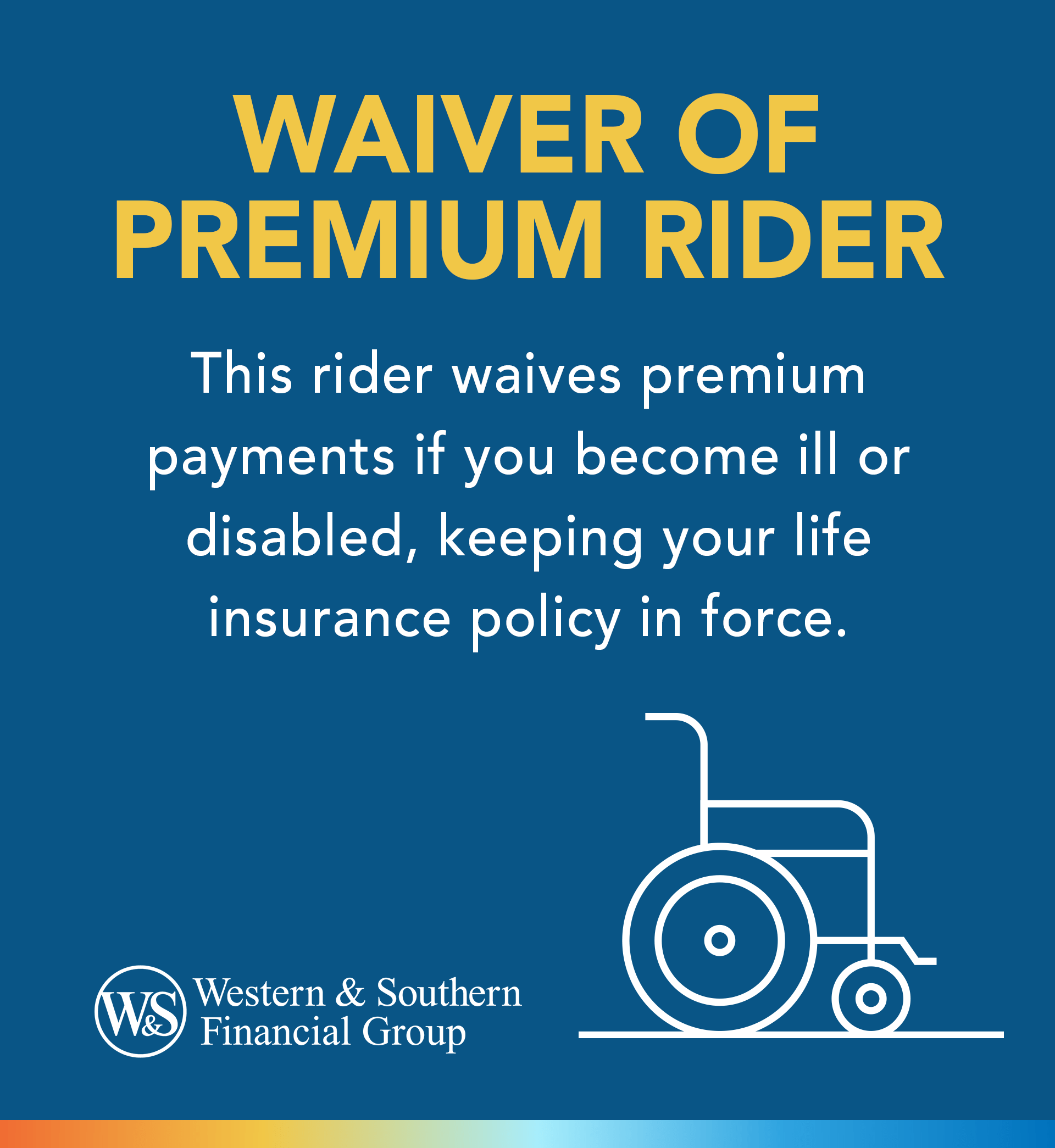 Waiver of Premium definition" />
Waiver of Premium definition" /> Waiver of Premium definition" />
Waiver of Premium definition" />A Waiver of Premium Rider is an optional add-on to a life insurance policy that will waive or pay your life insurance premiums for you if you become disabled and unable to work. This ensures your policy stays in force even if you can no longer afford the premiums yourself.
Updated April 25, 2024 Waiver of Premium definition" />
Waiver of Premium definition" /> Waiver of Premium definition" />
Waiver of Premium definition" />
A Waiver of Premium Rider is an add-on provision to a life insurance policy that ensures if the policyholder becomes seriously ill or disabled and is unable to continue working, the insurance company will waive the premium payments, allowing the policy to remain in force without any further payment from the policyholder.
Tip
A Waiver of Premium Rider can be added to permanent life insurance policies such as whole life insurance or universal life insurance. Depending upon the life insurance company, it may also be added to a term life insurance policy.
Understanding what a Waiver of Premium Rider is has significant implications for those seeking comprehensive protection through their life insurance policies. This rider is a crucial financial safety net during difficult times by providing a life insurance living benefit.
The Return of Premium Rider and the Waiver of Premium Rider are valuable add-ons to a life insurance policy, but they serve different purposes. Here's a clear breakdown of the differences:
Here's how the Waiver of Premium Rider generally works:
It's important to note that the specifics of a life insurance policy's death benefit and life insurance riders can vary depending on the insurance company and the specific policy terms and conditions. Always review the policy's details and consult with an insurance professional to fully understand life insurance options' benefits, limitations, and costs.
Discover how life insurance waivers can offer you security and assurance. Get a Life Insurance Quote
The Waiver of Premium Rider is a premium provision designed to provide financial relief to policyholders who encounter specific life challenges that impact their ability to pay premiums. The exact coverage can vary based on the insurance provider and the particular policy, but generally, the rider covers the following:
Disability: This is the most common trigger for the rider. Suppose the policyholder becomes disabled for an extended period (typically defined by the policy, often as a six-month waiting period or longer). In that case, the insurance company will waive the premiums for the duration of the disability. The definition of "total disability" can vary but usually means the policyholder cannot work in their regular occupation or any occupation they are suited for due to education, training, or experience.
Serious Illness: Some policies extend the rider to cover instances where the policyholder becomes critically ill, even if they're not classified as "totally disabled." Conditions might include heart attacks, strokes, certain types of cancer, or other specified illnesses.
Recovery Period: Some riders continue to waive premiums for a certain period after the policyholder recovers from their disability or illness, ensuring they have time to regain their financial footing.
Unemployment: While less common, some insurance providers may offer a version of the Waiver of Premium Rider that provides relief if the policyholder becomes involuntarily unemployed. Typically, conditions are attached, such as the policyholder must be unemployed for a certain period, and there might be limits on the duration the premiums are waived.
It's essential to read the fine print and consult with an insurance professional when considering the Waiver of Premium Rider. Insurance companies may have varying definitions, exclusions, waiting periods, and other terms that can influence the rider's coverage and effectiveness.
The Waiver of Premium Rider is typically available to anyone eligible for a life insurance policy. However, the specific eligibility criteria can depend on several factors, including the insurance company's underwriting guidelines, the type and term of the policy, and the laws and regulations in your location. Here are some common factors that insurers may consider:
Check if you qualify for life insurance premium waivers. Get a Life Insurance Quote
A Waiver of Premium Rider offers several benefits. Here are the main advantages:
While there are undeniable benefits to having a Waiver of Premium Rider, it's essential to evaluate one's personal health risk, family history, financial situation, and insurance coverage before deciding to add such a rider. It's also vital to thoroughly understand the rider's terms, conditions, and exclusions.
While the Waiver of Premium Rider provides valuable benefits, it's essential to consider its potential drawbacks:
As with all insurance decisions, weighing these potential drawbacks against the benefits is essential to determine if a Waiver of Premium Rider fits your needs.
Several factors influence the cost of a Waiver of Premium Rider and can vary among insurance providers. Here's a breakdown of the considerations that may affect its cost:
The insurer: Insurance companies price their products differently based on their underwriting guidelines and risk assessment models.
The policyholder: Age, health, lifestyle, occupation, and whether or not you smoke can all affect the cost of a life insurance premium, and this carries over into the cost of a Waiver of Premium Rider as well.
The policy: The life insurance policy's term length and coverage amount will affect the cost. Longer terms and more significant coverage amounts usually mean higher costs for the life insurance rider.
While the Waiver of Premium Rider offers a valuable layer of protection, its cost can be influenced by a mix of factors tied to the policyholder and the insurance provider. As such, it's crucial to balance the need for the added protection it provides with the additional cost.
Whether a Waiver of Premium Rider is worth it depends on your circumstances, financial goals, and risk tolerance. It can be a valuable addition for some individuals, but the extra cost may not be justified for others. Here are a few considerations to help determine if it might be right for you:
Risk Exposure: If your occupation or lifestyle carries a higher risk of injury or disability, the rider might offer invaluable protection.
Financial Situation: Consider your current savings and financial cushion. If you have significant savings or other sources of income that could cover your premiums during times of disability, the rider might be less critical.
Family Obligations: If you have dependents who rely on the death benefit of your insurance, ensuring the policy doesn't lapse might make the rider worth the cost.
Alternative Coverage: Do you have other insurance policies, like disability insurance, which could cover your expenses, including life insurance premiums, in case of illness or injury? If so, you might not need the rider.
As with all financial decisions, discussing your options with a financial advisor or insurance professional is recommended. They can help you evaluate the costs and benefits of financial protection based on your specific needs and goals.
Remember that various types of life insurance policies and optional life insurance riders may suit your needs and financial situation. It is important to take the time to thoroughly research buying life insurance and consider all available options, taking into account your financial objectives, family, and personal preferences.
Protect your life insurance premiums during health crises. Get a Life Insurance Quote
Essential Safeguard Add a waiver to protect your payments.














Information provided is general and educational in nature, and all products or services discussed may not be provided by Western & Southern Financial Group or its member companies (“the Company”). The information is not intended to be, and should not be construed as, legal or tax advice. The Company does not provide legal or tax advice. Laws of a specific state or laws relevant to a particular situation may affect the applicability, accuracy, or completeness of this information. Federal and state laws and regulations are complex and are subject to change. The Company makes no warranties with regard to the information or results obtained by its use. The Company disclaims any liability arising out of your use of, or reliance on, the information. Consult an attorney or tax advisor regarding your specific legal or tax situation.
![]()
Monday - Friday | 8 a.m. - 6 p.m. ET
Saturday | Closed
Sunday | Closed
Holidays | Closed
© 2017-2024 Western & Southern Financial Group, Inc.
Western & Southern is the marketing name for a group of diversified financial services businesses composed of Western & Southern Financial Group and its seven life insurance subsidiaries. Life insurance and annuity products may be issued by The Western and Southern Life Insurance Company, Western-Southern Life Assurance Company, Columbus Life Insurance Company, Integrity Life Insurance Company, The Lafayette Life Insurance Company, National Integrity Life Insurance Company or Gerber Life Insurance Company. Products and services referenced in this website are provided through multiple companies. Each company has financial responsibility only for its own products and services, and is not responsible for the products and services provided by the other companies. Not all products and services are available in all states. All companies are members of Western & Southern Financial Group and are located in Cincinnati, OH with the exception of National Integrity and Gerber Life, which are located in White Plains, NY.
This site is intended to provide a general overview of our products and services. Please review the details of each product with your financial representative to determine which options may best fit your needs.
Western & Southern Financial Group does not provide tax or legal advice. Please contact your tax or legal advisor regarding your situation. The information provided is for educational purposes only.
1 Superior ability to meet ongoing insurance obligations (second highest of 13 ratings; rating held since June 2009 for six out of seven of Western & Southern Financial Group’s life insurance subsidiaries, rating held since February 2024 for Gerber Life). Gerber Life is not rated by other rating agencies.
2 Very strong financial security characteristics (fourth highest of 21 ratings; rating held since August 2018)
3 Very strong capacity to meet policyholder and contract obligations on a timely basis (third highest of 21 ratings; rating held since June 2009)
4 Excellent financial security (fourth highest of 21 ratings; rating held since February 2009)
5 The Comdex Ranking is a composite of all the ratings a company has received from the major rating agencies. It ranks insurers on a scale of 1 to 100 (where 1 is the lowest) in an effort to reduce confusion over ratings because each rating agency uses a different scale.
Financial strength ratings apply to the individual member insurance companies affiliated with Western & Southern. Gerber Life is rated only by A.M. Best. The Lafayette Life Insurance Company is not rated by Moody’s.
This may contain information obtained from third-parties, including ratings from credit ratings agencies such as Standard & Poor’s. Reproduction and distribution of third-party content in any form is prohibited except with the prior written permission of the related third-party. Third-party content providers do not guarantee the accuracy, completeness, timeliness or availability of any information, including ratings, and are not responsible for any errors or omissions (negligent or otherwise), regardless of the cause, or for the results obtained from the use of such content. THIRD-PARTY CONTENT PROVIDERS GIVE NO EXPRESS OR IMPLIED WARRANTIES, INCLUDING, BUT NOT LIMITED TO, ANY WARRANTIES OF MERCHANTABILITY OR FITNESS FOR A PARTICULAR PURPOSE OR USE. THIRD-PARTY CONTENT PROVIDERS SHALL NOT BE LIABLE FOR ANY DIRECT, INDIRECT, INCIDENTAL, EXEMPLARY, COMPENSATORY, PUNITIVE, SPECIAL OR CONSEQUENTIAL DAMAGES, COSTS, EXPENSES, LEGAL FEES OR LOSSES (INCLUDING LOST INCOME OR PROFITS AND OPPORTUNITY COSTS OR LOSSES CAUSED BY NEGLIGENCE) IN CONNECTION WITH ANY USE OF THEIR CONTENT, INCLUDING RATINGS. Credit ratings are statements of opinions and are not statements of fact or recommendations to purchase, hold or sell securities. They do not address the suitability of securities or the suitability of securities for investment purposes, and should not be relied on as investment advice. Ratings are subject to change from time to time. The ratings shown here are correct as of February 20, 2024.
Gerber Life Insurance is a trademark. Used under license from Société des Produits Nestlé S.A. and Gerber Products Company.